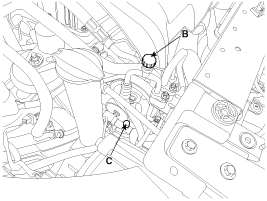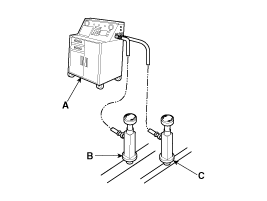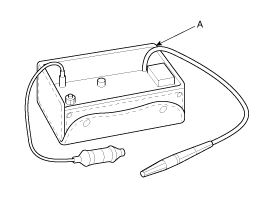 Kia Sedona: Air Conditioner Refrigerant/Compressor Repair procedures
Kia Sedona: Air Conditioner Refrigerant/Compressor Repair procedures
Third generation YP (2014-2025) / Kia Sedona YP Service Manual / Maintenance / Body / Air Conditioner Refrigerant/Compressor Repair procedures
| Refrigerant Recovery |
When removing HFC-134a (R-134a) from the air conditioning
system, use only U.L.-listed service equipment certified to meet the
requirements of SAE J2210.
|
If accidental system discharge occurs, ventilate the work area before resuming service.
Additional health and safety information may be obtained from the refrigerant and lubricant manufacturers.
| 1. |
Connect an R-134a refrigerant
Recovery/Recycling/Charging system (A) to the high-pressure
service port (B) and the low-pressure service port (C) as shown
according to the equipment manufacturer''s instructions.
|
| 2. |
Measure the amount of refrigerant oil removed from the A/C
system after the recovery process is completed. Be sure to install the
same amount of new refrigerant oil back into the A/C system before
charging. |
System Evacuation
When removing HFC-134a (R-134a) from the air conditioning
system, use only U.L.-listed service equipment certified to meet the
requirements of SAE J2210.
|
If accidental system discharge occurs, ventilate the work area before resume of service.
Additional health and safety information may be obtained from the refrigerant and lubricant manufacturers.
| 1. |
When an A/C system has been opened to the atmosphere, such as
during installation or repair, it must be evacuated using a R-134a
refrigerant Recovery/Recycling/Charging system. (If the system has been
open for several days, the receiver/drier should be replaced, and the
system should be evacuated for several hours.) |
| 2. |
Connect an R-134a refrigerant
Recovery/Recycling/Charging system (A) to the high-pressure
service port (B) and the low-pressure service port (C) as shown
according to the equipment manufacturer''s instructions.
|
| 3. |
If the low-pressure does not reach more than 93.3 kPa (700
mmHg, 27.6 in.Hg) in 10 minutes, there is probably a leak in the system.
Partially charge the system, and check for leaks (see Refrigerant Leak
Test.) |
| 4. |
Remove the low pressure valve from the low-pressure service port. |
System Charging
When removing HFC-134a (R-134a) from the air conditioning
system, use only U.L.-listed service equipment certified to meet the
requirements of SAE J2210.
|
If accidental system discharge occurs, ventilate the work area before resume of service.
Additional health and safety information may be obtained from the refrigerant and lubricant manufacturers.
| 1. |
Connect an R-134a refrigerant
Recovery/Recycling/Charging system (A) to the high-pressure
service port (B) as shown according to the equipment manufacturer''s
instructions.
|
| 2. |
Add the same amount of new refrigerant oil to the system that
was removed during recovery. Use only specified refrigerant oil. Charge
the system with [1100 ± 25g (38.8 ± 0.88oz.)] R-134a refrigerant. Do
not overcharge the system as the compressor may be damaged. |
Refrigerant Leak Test
Always conduct a leak test with an electronic leak detector
whenever leakage or refrigerant is suspected and when conducting service
operations which are accompanied by disassembly or loosening connection
fittings.
In order to use the leak detector properly, read the manual supplied by the manufacturer. |
If a gas leak is detected, proceed as follows:
| 1. |
Check the torque on the connection fittings and, if too
loose, tighten to the proper torque. Check for gas leakage with a leak
detector (A). |
| 2. |
If leakage continues even after the fitting has been
tightened, discharge the refrigerant from the system, disconnect the
fittings, and check their seating faces for damage. Always replace, even
if the damage is slight. |
| 3. |
Check the compressor oil and add oil if required. |
| 4. |
Charge the system and recheck for gas leaks. If no leaks are found, evacuate and charge the system again.
|
| Inspection |
| Compressor |
RPM check
| 1. |
Push the A/C control switch ON. |
| 2. |
Check the engine RPM.
|
| 3. |
During the compressor operation, RPM is as follows.
| |||||||||||||||
Sound check
| 1. |
Push the A/C control switch ON. |
| 2. |
Check the compressor from the engine room. |
| 3. |
During operation, the compressor makes a cracking sound.
|
 Body
Body
...
 Climate Control Air Filter Repair procedures
Climate Control Air Filter Repair procedures
Filter inspection
The climate control air filter should be replaced according to the maintenance schedule.
If the vehicle is operated in severely polluted city or on
dusty rough roads for a long ...
Other Information:
SRS components and functions
The SRS consists of the following components :
(1) Driver's front air bag module
(2) Passenger's front air bag module
(3) Side air bag modules
(4) Curtain air bag modules
(5) Retractor ...
General Information
Warning And Caution Labels
1. Fan caution2. Radiator cap caution3. Battery caution
Battery Caution Label
Warning / Caution Label (Cont''d)
A.Keep lighted cigarettes and all other flames or ...
Categories
- Home
- First Generation
- Second Generation
- Third generation
- Kia Sedona YP 2014-2025 Owners Manual
- Kia Sedona YP 2014-2025 Service Manual
Copyright © www.kisedona.com 2016-2025






